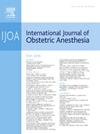Online patient information on labour epidural analgesia provided by UK NHS hospitals: assessment of readability and improvement of readability standards using ChatGPT
IF 2.6
3区 医学
Q2 ANESTHESIOLOGY
引用次数: 0
Abstract
Background
Labour epidurals are considered the gold standard for labour analgesia in pregnant patients. Inequities in health literacy levels can negatively impact understanding of online patient education materials, potentially affecting uptake of labour epidural analgesia. Generative artificial technology such as ChatGPT may be able to improve readability of patient information materials.
Objectives
Firstly, to assess the readability of available online materials on labour epidurals in the United Kingdom (UK). Secondly, to evaluate the ability of generative artificial technology to improve readability.
Methods
All UK public hospitals' websites performing obstetric anaesthesia were searched for patient education materials relating to labour epidurals. A readability assessment was conducted using three readability scoring systems. ChatGPT was used to rewrite content of online patient information material on labour epidural analgesia to be understandable by an individual with the health literacy level of an 11-year-old (sixth grade).
Results
A total of 61.6% of UK hospitals provided some form of online patient education materials on labour analgesia and epidurals, 14.5% and 23.2% of the texts, met the target readability in two commonly used readability scores, respectively. The mean grade (8.4 ± 2.1) did not meet target readability levels. After AI-modification, 24.6% and 27.5% of the texts met targets using the same metrics, with the mean grade (7.7 ± 1.2) decreasing significantly (P <0.001), but still not meeting the target level.
Conclusion
Online patient-information on labour epidural analgesia frequently exceeds the recommended sixth grade reading level. ChatGPT can be used to enhance readability but also fails to meet recommended health literacy standards.
英国NHS医院提供的分娩硬膜外镇痛的在线患者信息:使用ChatGPT评估可读性和改进可读性标准
分娩硬膜外麻醉被认为是孕妇分娩镇痛的黄金标准。卫生知识普及水平的不平等会对在线患者教育材料的理解产生负面影响,可能会影响硬膜外分娩镇痛的应用。像ChatGPT这样的生成式人工技术可以提高患者信息材料的可读性。目的:首先,评估英国硬膜外分娩在线资料的可读性。其次,评价生成式人工技术提高可读性的能力。方法检索英国所有公立医院产科麻醉网站,查找与硬膜外分娩相关的患者教育资料。使用三种可读性评分系统进行可读性评估。ChatGPT用于重写在线分娩硬膜外镇痛患者信息材料的内容,使其能够被具有11岁(六年级)健康素养水平的个体理解。结果61.6%的英国医院提供了某种形式的分娩镇痛和硬膜外患者在线教育材料,14.5%和23.2%的文本在两项常用的可读性评分中分别达到了目标可读性。平均评分(8.4±2.1)未达到目标可读性水平。人工智能修改后,24.6%和27.5%的文本达到了使用相同指标的目标,平均等级(7.7±1.2)显着下降(P <0.001),但仍未达到目标水平。结论网上分娩硬膜外镇痛的患者信息经常超过推荐的六年级阅读水平。ChatGPT可用于提高可读性,但也未能达到建议的卫生知识普及标准。
本文章由计算机程序翻译,如有差异,请以英文原文为准。
求助全文
约1分钟内获得全文
求助全文
来源期刊
CiteScore
4.70
自引率
7.10%
发文量
285
审稿时长
58 days
期刊介绍:
The International Journal of Obstetric Anesthesia is the only journal publishing original articles devoted exclusively to obstetric anesthesia and bringing together all three of its principal components; anesthesia care for operative delivery and the perioperative period, pain relief in labour and care of the critically ill obstetric patient.
• Original research (both clinical and laboratory), short reports and case reports will be considered.
• The journal also publishes invited review articles and debates on topical and controversial subjects in the area of obstetric anesthesia.
• Articles on related topics such as perinatal physiology and pharmacology and all subjects of importance to obstetric anaesthetists/anesthesiologists are also welcome.
The journal is peer-reviewed by international experts. Scholarship is stressed to include the focus on discovery, application of knowledge across fields, and informing the medical community. Through the peer-review process, we hope to attest to the quality of scholarships and guide the Journal to extend and transform knowledge in this important and expanding area.

 求助内容:
求助内容: 应助结果提醒方式:
应助结果提醒方式:


